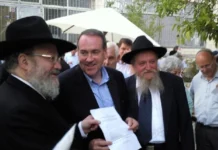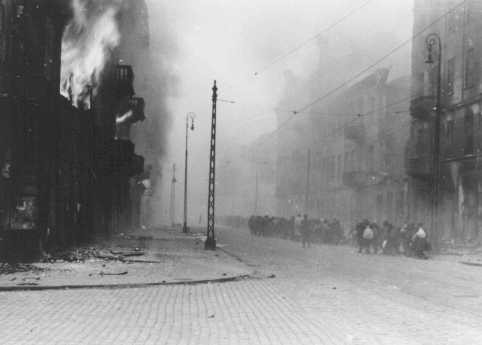On April 19, 1943, the Warsaw ghetto uprising began after German troops and police entered the ghetto to deport its surviving inhabitants. By May 16, 1943, the Germans had crushed the uprising and left the ghetto area in ruins. Surviving ghetto residents were deported to concentration camps or killing centers. The Warsaw ghetto uprising was the largest uprising led by Jews during World War II. It was the first significant urban revolt against German occupation in Europe.
![Deportation of Jewish women from the Warsaw ghetto. [LCID: 60566]](https://jewishwebsite.com/wp-content/uploads/2021/04/0d5442de-710c-4801-91f7-2f3f28acb8c6.jpg)
In response to the deportations, on July 28, 1942, several Jewish underground organizations created an armed self-defense unit known as the Jewish Combat Organization (Żydowska Organizacja Bojowa; ŻOB). Rough estimates put the size of the ŻOB at its formation at around 200 members.
The right-wing Revisionist Zionist movement, especially its youth group, Betar, served as the chief organizers of the Jewish Military Union (Żydowski Związek Wojskowy; ŻZW). Although initially there was tension between the ŻOB and the ŻZW, both groups decided to work together to oppose German attempts to destroy the ghetto. At the time of the uprising, the ŻOB had about 500 fighters in its ranks and the ŻZW had about 250.
While efforts to establish contact with the Polish military underground movement (Armia Krajowa, or Home Army) did not succeed during the summer of 1942, the ŻOB established contact with the Home Army in October, and obtained a small number of weapons, mostly pistols and explosives, from Home Army contacts.
In January 1943, German SS and police units returned to the Warsaw ghetto. This time, they intended to deport thousands of the remaining Jews in the ghetto to forced-labor camps in the Lublin District of the General Government. View This Term in the Glossary On January 18, 1943, in accordance with orders from Heinrich Himmler, SS and police units attempted to resume mass deportations of Jews from Warsaw.
A small group of Jewish fighters, armed with pistols, infiltrated a column of Jews being forced to the Umschlagplatz (transfer point) and, at a prearranged signal, broke ranks and fought their German escorts. Most of these Jewish fighters died in the battle, but the attack sufficiently disoriented the Germans to allow the Jews arranged in columns at the Umschlagplatz a chance to disperse. Jewish resistance leaders also encouraged fellow ghetto inhabitants to defy deportation orders and hide from German authorities. Seizing only 5,000–6,500 ghetto residents, the Germans suspended further deportations on January 21.
Encouraged by the apparent success of the resistance, people in the ghetto began to construct subterranean bunkers and shelters in preparation for an uprising should the Germans attempt a final deportation of all remaining Jews in the reduced ghetto.
April 19, 1943-May 16, 1943
The resistance that came to be known as the Warsaw Ghetto Uprising began on the evening of the Jewish holiday of Passover, on April 19, 1943. The ŻOB had received advanced warning of a final deportation action and had warned residents of the ghetto to retreat to their hiding places or bunkers.
![An underground bunker, built by Jews in Warsaw in preparation for anti-Nazi resistance. [LCID: 34073]](https://jewishwebsite.com/wp-content/uploads/2021/04/0ddc879a-06f1-422e-9656-7114c473f866.jpg)
The uprising lasted 27 days. Stroop had a considerable force at his disposal, some 2,054 soldiers and police, reinforced with artillery and tanks. Clashing with them, sometimes in hand-to-hand combat, were some 700 young Jewish fighters, poorly equipped and lacking in military training and experience. The ŻOB did have the advantage of waging a guerilla war, striking and then retreating to the safety of ghetto buildings, bunkers and underground tunnels. The general ghetto population likewise thwarted German deportation efforts, refusing to assemble at collection points and burrowing underground bunkers. In the end, German were forced to raze the ghetto to the ground, burning and demolishing block by block, in order to smoke out their prey.
The ghetto fighters and the population who supported them held the Germans at bay for nearly a month. On May 8, 1943, German forces succeeded in seizing ŻOB headquarters at 18 Miła Street. Anielewicz and many of his staff commanders are thought to have committed suicide in order to avoid capture. On May 16, Stroop announced in his daily report to Berlin that “The former Jewish Quarter in Warsaw is no more.”
The entire sky of Warsaw was red. Completely red.
—Benjamin Meed (oral history)
To symbolize the German victory, Stroop ordered the destruction of the Great Synagogue View This Term in the Glossary on Tłomackie Street on May 16, 1943. The ghetto itself lay in ruins.The SS and police deported approximately 42,000 Warsaw ghetto survivors captured during the uprising to the forced-labor camps at Poniatowa and Trawniki and to the Lublin/Majdanek concentration camp. Most of these Jews would be murdered at these camps in November 1943, in a two-day shooting operation known as Operation Harvest Festival (Erntefest). At least 7,000 Jews died fighting or in hiding in the ghetto, while the SS and police deported the approximately 7,000 Jews captured at the end of the fighting to their deaths at the Treblinka killing center.
![Photograph from SS General Juergen Stroop's report showing the Warsaw ghetto after the German suppression of the ghetto uprising. [LCID: 34091a]](https://jewishwebsite.com/wp-content/uploads/2021/04/65db8136-45c2-4ecd-ba78-c57968ab186c.jpg)
Even after the end of the uprising on May 16, 1943, individual Jews hiding out in the ruins of the ghetto continued to attack the patrols of the Germans and their auxiliaries.
The Warsaw ghetto uprising was the largest, symbolically most important Jewish uprising, and the first urban uprising, in German-occupied Europe. The resistance in Warsaw inspired other uprisings in ghettos (e.g., Bialystok and Minsk) and killing centers (Treblinka and Sobibor).
![Adolf Berman speaks at a memorial to mark the Warsaw ghetto uprising. [LCID: 90334]](https://jewishwebsite.com/wp-content/uploads/2021/04/853bbd5a-1671-48ea-aa44-d1a327a99dde.jpg)
Remembrance
Today, Days of Remembrance ceremonies to commemorate the victims and survivors of the Holocaust are linked to the dates of the Warsaw ghetto uprising.


























